|
| |
| |
| |
‘Dear old Bruges’
The English Colony in Bruges in the Nineteenth Century
The English have always been at home in Bruges. From the tenth century on they crossed the channel for commercial reasons, and thus, in the centuries that followed, England emerged as one of the most important merchant states in the Hanseatic Alliance. The English headquarters (or consulate / warehouse) was established in the Domus Anglorum. Once upon a time one of the representatives was William Caxton, father of the art of book printing in England. He was governor of the Merchant Adventurers when, in 1473-1474, he printed the first book in English, The Recuyell of Historyes of Troye, in Bruges, by order of Margaret of York, Duchess of Burgundy. Time after time in the course of history the seat of the counts of Flanders was a place of refuge for English rulers who were fleeing their land for political reasons. The oldest evidence in this respect relates to Queen Emma, widow of King Cnut or Canute, and Princess Gunhilda in the eleventh century. In 1471, in the time of The Kingmaker, Edward iv came to seek help from his sister Margaret of York, who was married to Charles the Bold. But Charles ii also, and his brother Henry, Duke of Gloucester, held their Court
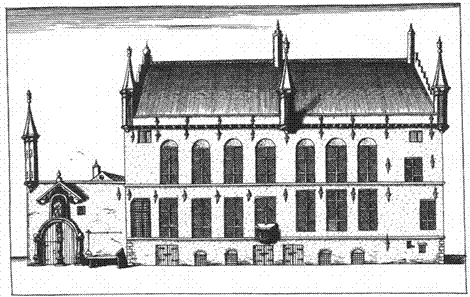
The Domus Anglorum (from: Antonius Sanderus, Flandria Illustrata. The Hague, 1641).
| |
| |
there in exile from 1656 to 1659, after Cromwell had driven them out of their country. During the repression under Elizabeth i many Roman Catholic subjects sought refuge in Flanders for religious reasons. In 1558 the English Carthusians established themselves in Bruges, and remained there for a century before moving to Nieuport. They were a powerful attraction to their compatriots. A similar influence was exerted by the English convent in Carmersstraat, founded in 1629, and by the third order of Saint Francis who had found a home in the former Prince's Residence from 1662 on. As early as 1762 the English Jesuits from Saint Omer built a new college on Spiegelrei on the site of the medieval Domus Anglorum. Only the convent in Carmersstraat has defied the passing of the centuries and the storms of revolutions.
In the seventeenth and eighteenth centuries, on repeated occasions, garrison soldiers were housed in barracks in the city. Some fell in love with a beauty of Bruges, married and integrated into local life. At the end of the eighteenth century a new sort of immigrant appeared. Due to the neutrality of the Austrian emperor, there was very considerable trade with the colonies via Ostend. Some owners and ship brokers, insurance agents and dealers in colonial goods chose Bruges as their place of residence. They formed the basis of the so-called English colony in the nineteenth century.
| |
After Waterloo
Thanks to Wellington's victory over the French army, from 1815 on we can almost speak of an English invasion of what is present-day Belgium. Large numbers of British subjects settled in Brussels, Liège, Verviers and Ghent. But nowhere was their presence so marked and so enduring as in Bruges. There were various reasons for this. The city was well-situated, close to the Channel and on the direct route (rail route from 1838) to the Rhineland. The cost of living in the West Flemish provincial town was much lower than in the other cities. Moreover, Bruges was a picturesque place with medieval buildings and ruins reflected in the water of the canals. Churches and monasteries held unknown art treasures. Finally, some of the British were attracted by the mystical side of Bruges, full of priests and nuns, processions and veneration of the saints.
On the return from Waterloo to Albion some former military men remained in the peaceful little town and, together with ex-colonials, formed the first members of an English-speaking colony which for a whole century was to be a constant element of the local population. A striking figure in that period was the Londoner John Steinmetz, gentleman of independent means and collector of prints, who had discovered Bruges in 1819 on his way to Venice and stayed there. He was in close contact with well-known French politicians and political writers such as Charles de Montalembert and Félicité de Lamennais, as well as with the art historian François Rio. His home in Sint-Jorisstraat acted as a sort of embassy for any of his compatriots visiting the city, many of whom, under his influence, maintained a second residence there.
Meanwhile modern tourism got underway. Bruges was a staging-post on the way to the battlefield of Napoleon and the banks of the Rhine, and many
| |
| |
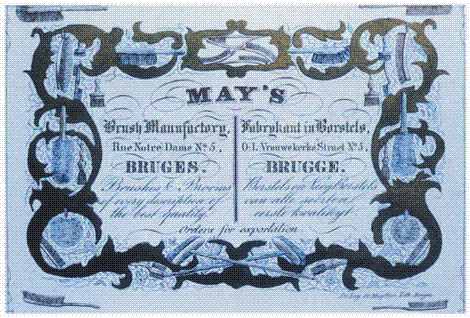
Porcelain visiting-card of the May's brush factory in Bruges. c. 1845 (Litho de Lay-De Muyttere, Bruges)
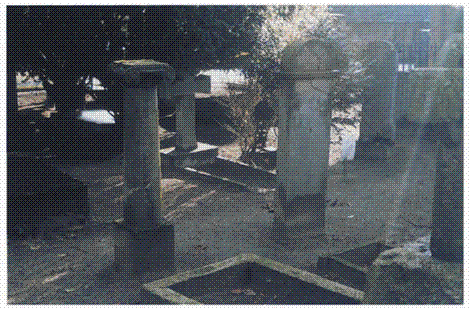
Memorials of Thomas Adolphus and Henry Trollope. 1835 (English Cemetery, Steenbrugge).
travellers noted their impressions of the town in letters and travel diaries. Artists immortalised the beauty spots in sketches and on canvas. The prints of Samuel Prout, Robert Hills and William Bartlett, with views of the city, served as unparalleled propaganda. The presence on the Belgian throne of Leopold i, the widower of the British crown princess Charlotte, was yet another reason for crossing the Channel.
In 1833 the Trollope family arrived in Bruges, to avoid creditors in their own country. In the Spring and Summer of 1834 there was a veritable craze among the London men and women of letters and artists for visiting ‘dear Mrs Trollope in Bruges’. Fanny, the mother of Anthony Trollope, had become famous with her book Domestic Manners of the Americans (1832). However, in Bruges, within the space of less than a year, she had carried to their graves in the English cemetery at Steenbrugge the bodies of her son Henry and her husband Thomas Adolphus, who had both succumbed to ty- | |
| |
phus. Nonetheless her enthusiastic descriptions in Belgium and Western Germany (1835) brought many British people to Belgium. In her book Mrs Trollope had a good eye for the plentiful sights and was also very much taken by the Catholic society. Thus the Irishwoman Margaret Hallahan, who had been a maid with an ex-colonials family since 1826, founded a community of the third order of Saint Dominic in 1841 under the influence of Catholicism in Bruges. In 1842 she became foundress of the Dominican nuns in England. To this day the sisters from Stone come on pilgrimage to Bruges, where Mother Margaret received her vocation.
| |
A fashionable place to be
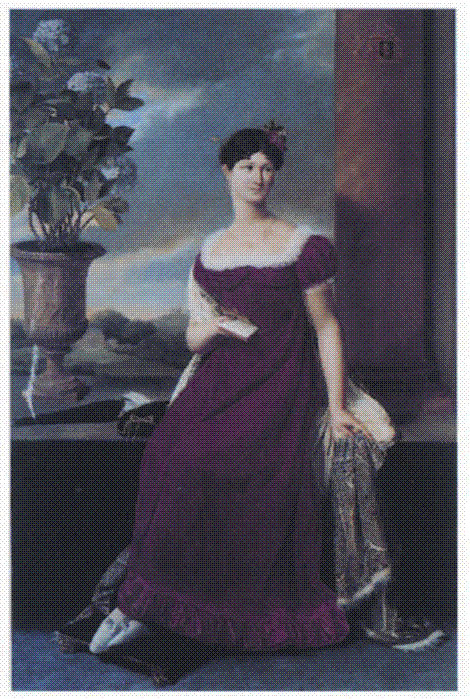
Joseph Ducq, Portrait of Mary Lodge. 1818. Groeningemuseum, Bruges.
A glance at the population records for the years 1825-1835 already shows a considerable British presence in Bruges. In 1846 the English colony numbered 404 members. In 1869 the figure had increased to 1200 and in 1890 it had dropped back to 800. However, these figures give a distorted picture, for many families would come year after year to spend the summer months in Bruges and the surrounding area. The majority rented a house or apartment, or stayed for months in one of the English hotels. The outbreak of the First World War signified an end to the permanent British presence in the city. In contrast to other foreigners who integrated readily into the Bruges community, the English-speaking contingent had always stressed their Englishness and maintained their own organisation. As early as 1815 the Anglicans had a place of worship and they were granted a portion of the city cemetery for their use, the so-called English cemetery. The children could attend various English schools, colleges or boarding establishments. In 1855 Arthur Robinson, from London, opened Saint Vincent's, an orphanage for English boys, and in 1858 the baronet Sir John Sutton of Norwood Park founded an English seminary to train missionaries for England and Scotland. Traditional Clubs were established, tea-rooms and shops were opened. They even had their own theatre where English plays were put on. For many subjects of the British Empire ‘dear old Bruges’ was a fashionable place to be.
There is no denying that the English colony in Bruges exerted a special influence on the city and its population. As early as 1814 a small number of traders and officials established the Philological Society, its aim being ‘to learn, to read and to speak fluently English’. Throughout the whole of the nineteenth century there were English evening classes for adults. When, in the 1830s, Bruges had already developed into a place of pilgrimage for the paintings of Hans Memling, this was largely thanks to Charles Baron de Keverberg de Kessel, who in 1817 had fallen in love in Bruges with the Englishwoman Mary Lodge, from Rochdale. Inspired by his young bride, he wrote Ursula Princesse Brittanique (1818), the first monograph about Memling's Shrine of Saint Ursula. It is likewise no matter of chance that Ford Madox Brown, one of the founders of the pre-Raphaelites in England, who as a young man had his early training at the Bruges Academy for Architecture and Draughtsmanship in 1827, later pointed Edward Burne Jones and William Morris in the direction of medieval Bruges and the fifteenth-century Masters in the Academy Museum.
Eminent visitors were originally shown round by the city librarian and
| |
| |
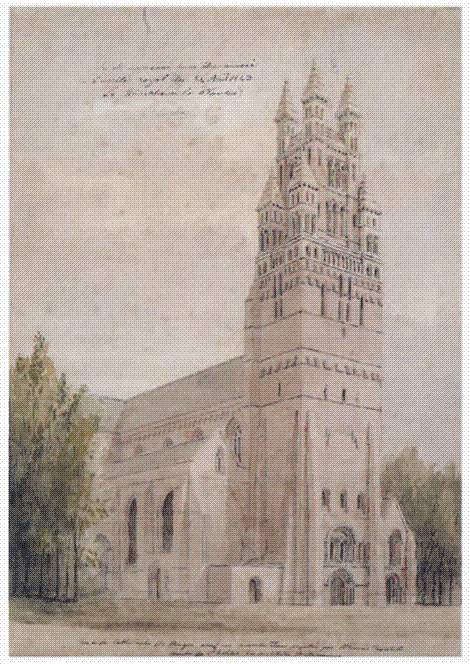
W. Chantrell, Wash Drawing for the Tower of Saint Saviour's in Bruges. 1840. Rijksarchief, Bruges (Photo by Hugo Maertens).
archivist Joseph Octave Delepierre, who had married the Englishwoman Emily Napier. On the lines of the English albums with views of cities, he published a beautiful Album Pittoresque (1837) and in response to the increasing number of visitors he produced the first guide to the city, the Guide dans Bruges (1838). Delepierre concluded his career as consul at the Belgian legation in London, where he promoted his ancient home town.
Without doubt the admiration of the English tourists and residents for the old buildings and art treasures encouraged the restoration of the monuments. When the Saint Saviour's Cathedral went up in flames in 1839, architect Robert Chantrell, from Leeds, immediately made a sketch for a new tower in Neo-Romanesque style. In so doing he produced the first expression of the English Gothic Revival in the city.
| |
Gothic revival
The pre-eminently Catholic city of Bruges afforded an ideal breeding-ground for the followers of the Catholic Revival and also for the converts to the Oxford Movement. Even before 1848 the embroiderer Louis Grossé was producing paraments which corresponded to the guidelines of Pugin's
| |
| |
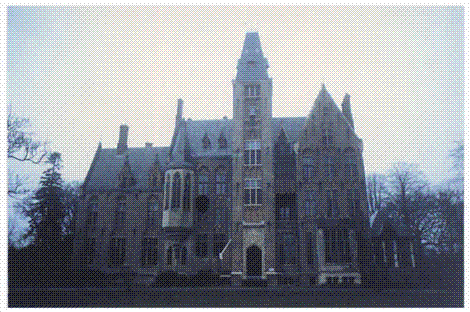
Neo-Gothic Manor of Van Caloen de Gourcy at Loppem near Bruges (built by Jean Bethune, 1850-1866).
Glossary of Ecclesiastical Ornament and Costume (1844). The high priest of Neo-Gothic had visited Bruges himself on various occasions. However, it was one of his former pupils, namely Thomas Harper King, who published the tenets of his master in Les vrais principes de l'architecture ogivale ou chrétienne in 1850 in Bruges. That came about as a result of the wrong principles having been used when the new church of Mary Magdalene was built, and King's official protest at this. The Englishman could count on the support of influential members of the English colony who were benefactors of the church. In addition King, a convert, had the sympathy of Bishop Jean-Baptiste Malou, an old friend of Cardinal Wiseman and a great admirer of Pugin. However, it was the Belgian Jean Baptiste Bethune, who, as designer and architect, gave shape to the theories of the English grand master on a large scale. Like Pugin, he strove after the principles of the height of Gothic in the thirteenth century, aiming to create a new form language from them. In so doing he also returned to the original materials and medieval techniques. He developed his activities, initially under the guidance of King and with the support of Pugin himself, first in Bruges and then from 1858 onwards in Ghent. A whole spectrum of decorative crafts grew up round his workshop, including the glass studios of Samuel Coucke and Jules Dobbelaere, and the sculpture studios of Jules van Nieuwenhuyse and Cesar de Jonghe. In the area around Bruges the most striking examples of Bethune's English-inspired Neo-Gothic realisations are the complex of Vivenkapelle (1860-1877) and the Van Caloen Manor at Loppem (1855-1866).
The Londoner James W.H. Weale left his stamp on Bruges to an extent equalled by no other member of the English colony. He lived there from 1855 until 1878. In that short period of time he showed himself to be a champion of the preservation of monuments and historic buildings, promoter of Neo-Gothic art and renewer of art-historical research in Flanders. As an ardent convert and follower of the Gothic Revival he fought with missionary zeal, in publications and lectures, against vandalism with regard to medieval works of art. It is largely thanks to Weale that Bruges has retained its old ramparts and city gates. Through his scholarly publications, by the establishment
| |
| |
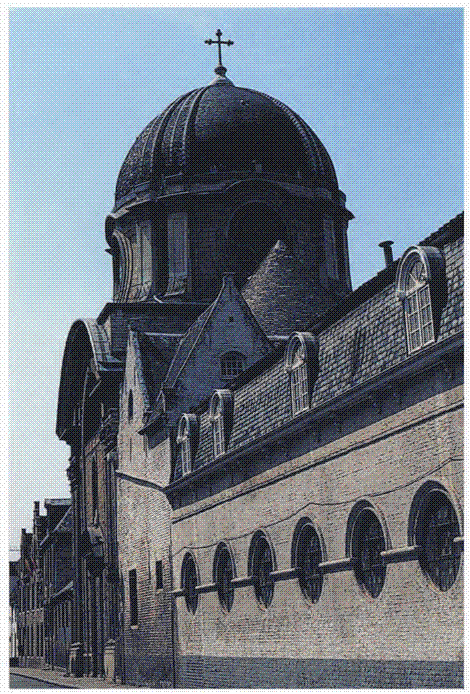
The English convent in Carmersstraat, with its domed church (1736-1739).
of antiquarian societies and journals on the history of art, people were made aware of the richness of the artistic patrimony. His work signifies a milestone in the rehabilitation and study of fifteenth- and sixteenthcentury art, particularly Flemish painting. His approach to conservation was revolutionary.
Through Weale's intervention William Curtis Brangwyn came to Bruges in 1863, and worked there for a decade as designer and architect. Among other things, he was involved in 1866-1867 in painting the Chapel of the Holy Blood in polychrome, and in 1870 the Chapel of Saint Julian was built to his plans. His son, Frank Brangwyn, who was born in 1867, donated a large collection of his works of art to the city of his birth, where they are currently preserved in the Brangwyn Museum.
The English colony in Bruges in the nineteenth century made a unique contribution to the cultural-historical, and even to the economic, importance of the city. If Bruges has preserved its medieval appearance to the present day, if it is a leading city in the area of preservation of buildings and monuments and is renowned throughout the world as a tourist centre and city of art trea- | |
| |
sures, then this is largely due to the effort and influence of exceptional English people who lived there.
lori van biervliet
Translated by Sheila M. Dale.
| |
References
| biervliet, lori van, W.H. James Weale, een Engels kunsthistoricus in Vlaanderen in de 19de eeuw. Verhandelingen van de Koninklijke Academie voor Wetenschappen, Letteren en Schone Kunsten van België. Klasse der Schone Kunsten, jaargang 53 nr. 55, Brussels, 1991 (A biographical bibliography of the English art historian James Weale, with a summary in English). |
| Idem, De brieven van W.H. James Weale aan Jozef A. Alberdingk Thijm. Bruges, 1991 (Edition of French-language letters as source for the evolution of Weale's career in Flanders). |
| Idem, De relatie van W.H. James Weale met Jean Bethune. Brieveneditie. Bruges, 1996 (Edition of French- and English-language letters of James Weale to Jean Bethune, the most important Neo-Gothic architect in Belgium). |
| Idem, ‘James Weale and Monumental Brasses’, Transactions of the Monumental Brass Society, vol. xiv, part 2 (1987), pp. 115-122. |
| Idem, ‘De Engelse kolonie in Brugge in de 19de eeuw’, Biekorf, 88 (1988), pp. 150-166 and 261-282. |
| Idem, ‘Bruges, cultural cross-roads in 19th-century Europe’. In: vermeersch, valentin (ed.), Bruges and Europe. Antwerp, 1992, pp. 383-403. |
| Idem, ‘Over neogotiek en in het bijzonder in het Brugse’, Biekorf, 94 (1994), pp. 56-73. |
| Idem, ‘De roem van Memling’. In: vos. dirk de (ed.), Hans Memling Essays. Ghent, 1994. pp. 109-124. |
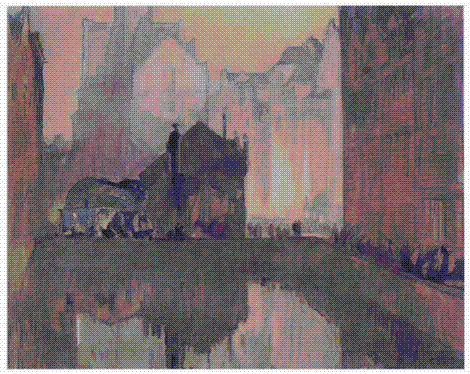
Frank Brangwyn, Jan van Eyck Place in Bruges. 1906. Brangwynmuseum, Bruges.
|
|